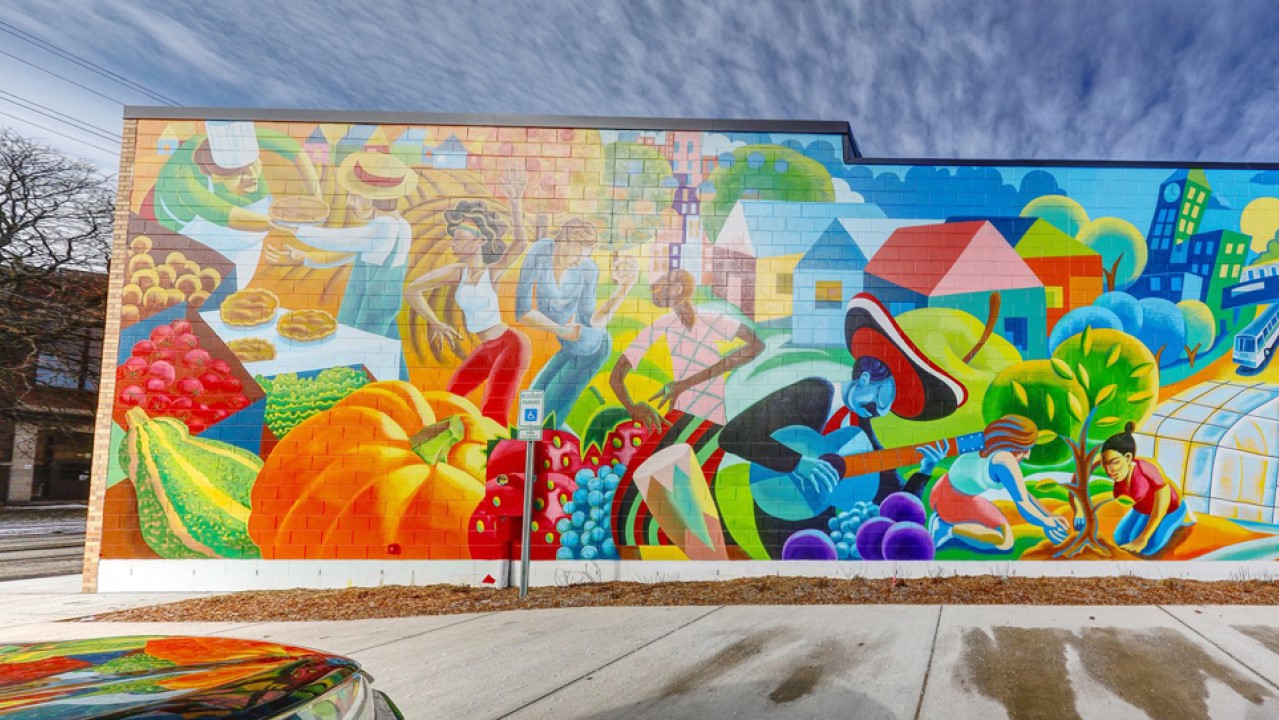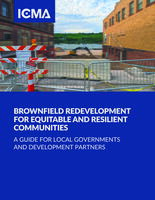
Even though the definition of a brownfield site is just a few decades old, the longer lens of history shows that redevelopment is a constantly occurring event in municipalities and communities. Today, brownfield redevelopment is a critical practice for community revitalization, involving identification and realization of economic, environmental, and social goals. These sites of former industrial or commercial activity are often in disrepair, not up to building code, and/or out of compliance with local zoning ordinances and modern design guidelines.
In addition to direct site conditions, brownfields are often located in areas subject to general disinvestment, depressed property values, and below-market rents that can make redevelopment less attractive or financially viable than their greenfield counterparts. Given these many direct and contextual challenges, brownfield redevelopment often requires significant financial support, capacity building, and partnerships between community stakeholders, officials, developers, and planners.
Beyond these perpetual challenges to redevelopment, communities are contending with urgent concerns related to recovery from a global pandemic, a warming planet, and heightened attention to social and economic disparities. However, public and private stakeholders are modeling innovative practices, programs, and projects that support brownfield redevelopment and more resilient and equitable communities.
To support local government leaders, their partners, and their people in the face of these intersectional challenges and opportunities, ICMA and the Michigan Economic Development Corporation (MEDC) have partnered to produce a new guide, Brownfield Redevelopment for Equitable and Resilient Communities.
The guide provides background on the enduring and more recent factors influencing brownfield redevelopment, and an overview of national, regional, state, and local technical assistance, tools, and resources available to support effective and sustainable redevelopment.
Its core content includes examples and guidance — including tips for local governments — on emerging and leading practices that advance community resilience and equitable development. The following is a preview of themes and examples covered at length in the full guide.
Incremental Development
Redeveloping places with smaller-scale projects can provide a path to more sustainable and community-supported revitalization. Incrementally scaled projects can be calibrated to specific local needs, such as addressing missing middle housing or catalyzing revitalization of stagnant commercial corridors. These types of redevelopments can be thoughtfully planned for and implemented by local people, ensuring that the end product is appropriate and attainable for those in the community rather than perpetuating displacement.
Hudson Center | Hudsonville, Michigan, USA
Hudsonville, a small suburb of approximately 7,000 residents outside Grand Rapids, aimed to redevelop its downtown after decades without any new development.
Along with adopting a 2030-focused master plan in 2015, it underwent the process to become certified as “Redevelopment Ready” by the MEDC. Completed in 2019, the Hudson Center project catalyzed the realization of the city’s vision and involved the rehabilitation of an existing building along with the construction of a new three-story, mixed-use building containing 8,400 square feet of ground floor retail/restaurant space, 8,400 square feet of office space on the second floor, and nine market-rate residential apartments on the third floor.
The Hudsonville Downtown Development Authority invested $150,000 of tax increment financing, and the MEDC committed gap financing of $686,645 through its Community Revitalization Program. These public dollars leveraged an additional $4.2 million in private investment and the project created 27 new jobs for the community.
Emerging Developer Initiatives
Recognition of the heightened barriers to entry faced by people of color, women, small-scale, and/or other demographics outside the typical real estate or commercial developer profile has given rise to an array of capacity-building initiatives across the country. These “emerging developer” programs typically provide a combination of tools and resources, coaching and training, networking, and/or direct access to capital, helping to keep wealth in a community and fostering career pathways for historically underserved populations.
The MEDC’s Developer Toolkit provides a one-stop shop of online, open-access guidance especially for those newer to real estate development. It emphasizes important steps to take even prior to pre-development, such as accessing training or technical assistance via embedded webinar recordings, accessing training or assistance provided by community partners, finding a mentor, or engaging with local or state professional networks. While many of the partners and programs referenced are Michigan-based, much of the guidance is generally applicable to real estate development if a complementary resource is not available for your state. Local governments can also consider emulating this approach on their own websites by consolidating links to similar resources and annotating lists with plain language narration on navigating the process.
Creative Placemaking
Creative placemaking is an approach for community development that integrates arts, culture, and creativity into the process of community-driven problem solving. By leveraging artistic and cultural activities, communities can transform public spaces, neighborhoods, and communities, as well as discover new ways of working through persistent challenges and opportunities to center equity in development.
City Hall Artspace Lofts | Dearborn, Michigan, USA
In Dearborn, a suburb of roughly 108,000 just outside Detroit, nonprofit developer Artspace converted historic buildings into a mixed-use park specifically for the Dearborn arts community.
Working with the city and community stakeholders, Artspace rehabilitated the historic Dearborn City Hall, former police station, and surrounding area into 53 affordable live-work units for artists. The development also includes several galleries and over 19,000 square feet of commercial area for non-resident artists and arts organizations, as well as live-work space for the Arab American National Museum’s artist residency program and space dedicated to housing the local high school’s public art project, “Pockets of Perception.” Residents from all over Dearborn visit the park for community events like its summertime jazz festival and holiday open studios.
This $15.8 million project included a $1,000,000 investment from the MEDC’s Community Revitalization Program, $7,921,010 in Federal Low Income Housing Tax Credits, and $2,464,335 in Federal Historic Tax Credits. These funds were supplemented by $800,000 in local investments and $3,459,296 in philanthropic investments.
Green Infrastructure and Resiliency
By integrating climate resiliency into brownfield redevelopment approaches, communities can simultaneously address environmental contamination, revitalize abandoned spaces, and build sustainable, adaptive, and resilient neighborhoods. Examples can include strategies to manage stormwater runoff, reduce flood risk, and mitigate urban heat island effects; incorporating native vegetation, restoring wetlands, and creating green spaces; and incorporating solar panels, wind turbines, or other clean energy systems.
Mitchell Bentley Solar Garden | Cadillac, Michigan, USA
Originally owned by the Cadillac Handling Company, this property was used to create manufactured wood products for boats. In 1971, the property was bought by Mitchell Bentley Corporation and used to make automobile parts. After the Mitchell Corporation filed for bankruptcy in 2010, the city took ownership of the property. In 2013, a devastating fire burned down most of the building, leaving 5,000 tons of burnt asbestos debris and harmful compounds in the soil. The Michigan Department of Environment, Great Lakes, and Energy (EGLE) utilized $950,000 in brownfield redevelopment grant funding and a $300,000 loan to remove the burned debris and test the soil. Consumers Energy purchased the property and recycled much of the concrete and steel to create a 2.77-acre community-based solar garden. This solar garden is Consumers Energy’s first brownfield to brightfield project and generates .5 MW of electricity.
Adaptive Reuse
Repurposing existing structures instead of constructing new ones on undeveloped land can help to conserve natural resources, preserve green spaces, and protect ecologically sensitive areas. Communities can avoid the environmental impact associated with demolishing old structures and the need for additional infrastructure development. Repurposing and restoring historic sites can help communities retain their unique character and architectural legacy, enhancing the overall sense of place.
Book Tower | Detroit, Michigan, USA
In 2018, the Michigan Strategic Fund approved the first-ever Transformational Brownfield Project (TBP) award in support of Bedrock’s $2.1 billion private investment in four iconic properties around downtown Detroit: Hudson Tower, One Campus Martius, Monroe Block, and Book Tower.
Collectively, the proposed redevelopment forecasts 7,738 new jobs and a positive net economic impact of 3 to 1. The TBP was valued at $618 million, which will be reimbursed to the development team over 30 years. The rehabilitation of the Book Tower and Book Building is one of the largest adaptive reuse projects in Michigan. The building was built in 1926 by the Book Brothers and, at the time, was the tallest building in Detroit. Standing at 685 feet, the building remains an anchor of the Detroit skyline after a $300 million historic restoration, which took over seven years. Such ornate architectural details as caryatids, ceiling tiles, art glass panels, and more were restored and replaced to preserve the original character, with other improvements made for modern functionality and energy efficiency. The 38-story building now offers 229 residential units, 117 ROOST Apartment Hotel accommodations, and 52,000 square feet of retail, office, and dining options.
Small-Scale Manufacturing
Prioritizing a small-scale manufacturing sector where local makers and startups establish niche manufacturing businesses focused on specialized products can yield economic benefits for local people and places. Brownfield properties usually have existing infrastructure, such as buildings, utilities, and transportation network assets to be leveraged by small-scale manufacturers and makers. By establishing small manufacturing businesses on brownfield sites, skilled and semi-skilled jobs can be created, providing employment to local residents and contributing to the local economy.
Allen Place | Lansing, Michigan, USA
Allen Neighborhood Center (ANC), a place-based hub located in the capital city’s diverse Eastside neighborhood, launched a farmers market pilot in 2004 in response to high rates of food insecurity among its residents. The successful market has since propelled growth of programming and infrastructure to foster a strong regional food system.
As remaining commercial tenants adjacent to the ANC moved out of its complex — which originally housed a gas station and two dry cleaners — plans for a full redevelopment rooted in support for local urban growers and food entrepreneurs began to gain traction. The center secured an $850,000 cleanup grant in 2019 from the state’s Department of Environment, Great Lakes, and Energy and a $1.5 million Community Revitalization Program grant from the MEDC in 2020. ANC’s strong community connections, including a partnership with community development financial institution Cinnaire Solutions, leveraged over 30 supporters of the $11 million project.
Reconstruction took place between September 2020 and February 2022. The property is now a mixed-use building containing an accelerator kitchen that supports the launch and scaling of local food businesses, a community food cooperative grocery store, a health clinic and pharmacy, and 21 units of mixed-income housing. Local artist Brian Whitfield was inspired by this project and painted a mural on the side of the building.
Learn More

Access more extensive examples, including from other states and regions, along with additional recommendations and links to resources in Brownfield Redevelopment for Equitable and Resilient Communities.
References
ICMA’s Guide to Creative Placemaking
ICMA’s Guide to Green Infrastructure Financing
Michigan Economic Development Corporation (MEDC) Project Profiles
Kathleen Achtenberg, “MSF-Approved Projects Generate Nearly $2.7 billion in Investment, Create or Retain 9,372 jobs,” Michigan Economic Development Corporation
Lawrence Cosentino, “Work Begins on East Side’s Allen Place Project,” City Pulse, September 23, 2020
New, Reduced Membership Dues
A new, reduced dues rate is available for CAOs/ACAOs, along with additional discounts for those in smaller communities, has been implemented. Learn more and be sure to join or renew today!
